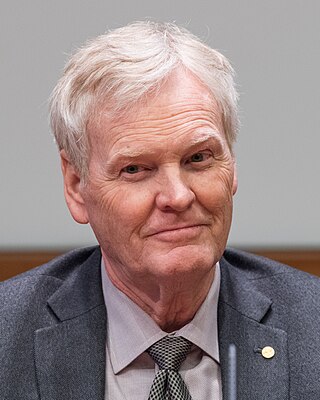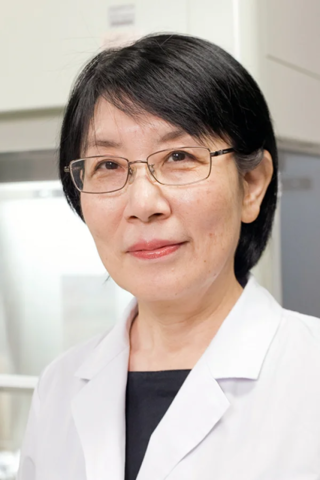
A circadian rhythm, or circadian cycle, is a natural oscillation that repeats roughly every 24 hours. Circadian rhythms can refer to any process that originates within an organism and responds to the environment. Circadian rhythms are regulated by a circadian clock whose primary function is to rhythmically co-ordinate biological processes so they occur at the correct time to maximise the fitness of an individual. Circadian rhythms have been widely observed in animals, plants, fungi and cyanobacteria and there is evidence that they evolved independently in each of these kingdoms of life.

Chronobiology is a field of biology that examines timing processes, including periodic (cyclic) phenomena in living organisms, such as their adaptation to solar- and lunar-related rhythms. These cycles are known as biological rhythms. Chronobiology comes from the ancient Greek χρόνος, and biology, which pertains to the study, or science, of life. The related terms chronomics and chronome have been used in some cases to describe either the molecular mechanisms involved in chronobiological phenomena or the more quantitative aspects of chronobiology, particularly where comparison of cycles between organisms is required.
Erwin Bünning was a German biologist. His most famous contributions were to the field of chronobiology, where he proposed a model for the endogenous circadian rhythms governing plant photoperiodism. From these contributions, Bünning is considered a co-founder of chronobiology along with Jürgen Aschoff and Colin Pittendrigh.

Jürgen Walther Ludwig Aschoff was a German physician, biologist and behavioral physiologist. Together with Erwin Bünning and Colin Pittendrigh, he is considered to be a co-founder of the field of chronobiology.
Joseph S. Takahashi is a Japanese American neurobiologist and geneticist. Takahashi is a professor at University of Texas Southwestern Medical Center as well as an investigator at the Howard Hughes Medical Institute. Takahashi's research group discovered the genetic basis for the mammalian circadian clock in 1994 and identified the Clock gene in 1997. Takahashi was elected to the National Academy of Sciences in 2003.
Colin Stephenson Pittendrigh was a British-born biologist who spent most of his adult life in the United States. Pittendrigh is regarded as the "father of the biological clock," and founded the modern field of chronobiology alongside Jürgen Aschoff and Erwin Bünning. He is known for his careful descriptions of the properties of the circadian clock in Drosophila and other species, and providing the first formal models of how circadian rhythms entrain (synchronize) to local light-dark cycles.
Ronald J. Konopka (1947-2015) was an American geneticist who studied chronobiology. He made his most notable contribution to the field while working with Drosophila in the lab of Seymour Benzer at the California Institute of Technology. During this work, Konopka discovered the period (per) gene, which controls the period of circadian rhythms.

Michael Warren Young is an American biologist and geneticist. He has dedicated over three decades to research studying genetically controlled patterns of sleep and wakefulness within Drosophila melanogaster.
Ueli Schibler is a Swiss biologist, chronobiologist and a professor at the University of Geneva. His research has contributed significantly to the field of chronobiology and the understanding of circadian clocks in the body. Several of his studies have demonstrated strong evidence for the existence of robust, self-sustaining circadian clocks in the peripheral tissues.

Carl Hirschie Johnson is an American-born biologist who researches the chronobiology of different organisms, most notably the bacterial circadian rhythms of cyanobacteria. Johnson completed his undergraduate degree in Honors Liberal Arts at the University of Texas at Austin, and later earned his PhD in biology from Stanford University, where he began his research under the mentorship of Dr. Colin Pittendrigh. Currently, Johnson is the Stevenson Professor of Biological Sciences at Vanderbilt University.
Paul Hardin is an American scientist in the field of chronobiology and a pioneering researcher in the understanding of circadian clocks in flies and mammals. Hardin currently serves as a distinguished professor in the biology department at Texas A&M University. He is best known for his discovery of circadian oscillations in the mRNA of the clock gene Period (per), the importance of the E-Box in per activation, the interlocked feedback loops that control rhythms in activator gene transcription, and the circadian regulation of olfaction in Drosophila melanogaster. Born in a suburb of Chicago, Matteson, Illinois, Hardin currently resides in College Station, Texas, with his wife and three children.
Martha Merrow is an American chronobiologist. She currently chairs the Institute of Medical Psychology at the Ludwig Maximilian University of Munich. Her career focuses primarily on investigating the molecular and genetic mechanisms of the circadian clock. Since joining the Ludwig Maximilian University in 1996, Merrow has investigated molecular and genetic mechanisms of the circadian clock as well as daily human behavior and medical psychology.
James "Jim" William Truman is an American chronobiologist known for his seminal research on circadian rhythms in silkmoth (Saturniidae) eclosion, particularly the restoration of rhythm and phase following brain transplantation. He is a professor emeritus at the University of Washington and a former senior fellow at Howard Hughes Medical Institution Janelia Research Campus.
Hajime Tei is a Japanese neuroscientist specializing in the study of chronobiology. He currently serves as a professor at the Kanazawa University Graduate School of Natural Science & Technology. He is most notable for his contributions to the discovery of the mammalian period genes, which he discovered alongside Yoshiyuki Sakaki and Hitoshi Okamura.
Carla Beth Green is an American neurobiologist and chronobiologist. She is a professor in the Department of Neuroscience and a Distinguished Scholar in Neuroscience at the University of Texas Southwestern Medical Center. She is the former president of the Society for Research on Biological Rhythms (SRBR), as well as a satellite member of the International Institute for Integrative Sleep Medicine at the University of Tsukuba in Japan.
In the field of chronobiology, the dual circadian oscillator model refers to a model of entrainment initially proposed by Colin Pittendrigh and Serge Daan. The dual oscillator model suggests the presence of two coupled circadian oscillators: E (evening) and M (morning). The E oscillator is responsible for entraining the organism’s evening activity to dusk cues when the daylight fades, while the M oscillator is responsible for entraining the organism’s morning activity to dawn cues, when daylight increases. The E and M oscillators operate in an antiphase relationship. As the timing of the sun's position fluctuates over the course of the year, the oscillators' periods adjust accordingly. Other oscillators, including seasonal oscillators, have been found to work in conjunction with circadian oscillators in order to time different behaviors in organisms such as fruit flies.

Sato Honma is a Japanese chronobiologist who researches the biological mechanisms of circadian rhythms. She mainly collaborates with Ken-Ichi Honma on publications, and both of their primary research focuses are the human circadian clock under temporal isolation and the mammalian suprachiasmatic nucleus (SCN), its components, and associates. Honma is a retired professor at the Hokkaido University School of Medicine in Sapporo, Japan. She received her Ph.D. in physiology from Hokkaido University. She taught physiology at the School of Medicine and then at the Research and Education Center for Brain Science at Hokkaido University. She is currently the director at the Center for Sleep and Circadian Rhythm Disorders at Sapporo Hanazono Hospital and works as a somnologist.
Johanna H. Meijer is a Dutch scientist who has contributed significantly to the field of chronobiology. Meijer has made notable contributions to the understanding of the neural and molecular mechanisms of circadian pacemakers. She is known for her extensive studies of photic and non-photic effects on the mammalian circadian clocks. Notably, Meijer is the 2016 recipient of the Aschoff and Honma Prize, one of the most prestigious international prizes in the circadian research field. In addition to still unraveling neuronal mechanisms of circadian clocks and their applications to health, Meijer's lab now studies the effects of modern lifestyles on our circadian rhythm and bodily functions.
Ken-Ichi Honma is a Japanese chronobiologist who researches the biological mechanisms underlying circadian rhythms. After graduating from Hokkaido University School of Medicine, he practiced clinical psychiatry before beginning his research. His recent research efforts are centered around photic and non-photic entrainment, the structure of circadian clocks, and the ontogeny of circadian clocks. He often collaborates with his wife, Sato Honma, on work involving the mammalian suprachiasmatic nucleus (SCN).

Eclosion assays are experimental procedures used to study the process of eclosion in insects, particularly in the model organism drosophila. Eclosion is the process in which an adult insect emerges from its pupal case, or a larval insect hatches from its egg. In holometabolous insects, the circadian clock regulates the timing of adult emergence. The daily rhythm of adult emergence in these insects was among the first circadian rhythms to be investigated. The circadian clock in these insects enforces a daily pattern of emergence by permitting or triggering eclosion during specific time frames and preventing emergence during other periods.






